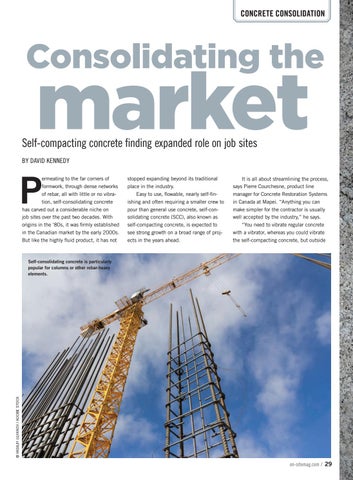CONCRETE CONSOLIDATION
Consolidating the
market
Self-compacting concrete finding expanded role on job sites BY DAVID KENNEDY
P
ermeating to the far corners of formwork, through dense networks of rebar, all with little or no vibration, self-consolidating concrete has carved out a considerable niche on job sites over the past two decades. With origins in the ‘80s, it was firmly established in the Canadian market by the early 2000s. But like the highly fluid product, it has not
stopped expanding beyond its traditional place in the industry. Easy to use, flowable, nearly self-finishing and often requiring a smaller crew to pour than general use concrete, self-consolidating concrete (SCC), also known as self-compacting concrete, is expected to see strong growth on a broad range of projects in the years ahead.
It is all about streamlining the process, says Pierre Courchesne, product line manager for Concrete Restoration Systems in Canada at Mapei. “Anything you can make simpler for the contractor is usually well accepted by the industry,” he says. “You need to vibrate regular concrete with a vibrator, whereas you could vibrate the self-compacting concrete, but outside
© VASILIY ULYANOV / ADOBE STOCK
Self-consolidating concrete is particularly popular for columns or other rebar-heavy elements.
on-sitemag.com / 29









